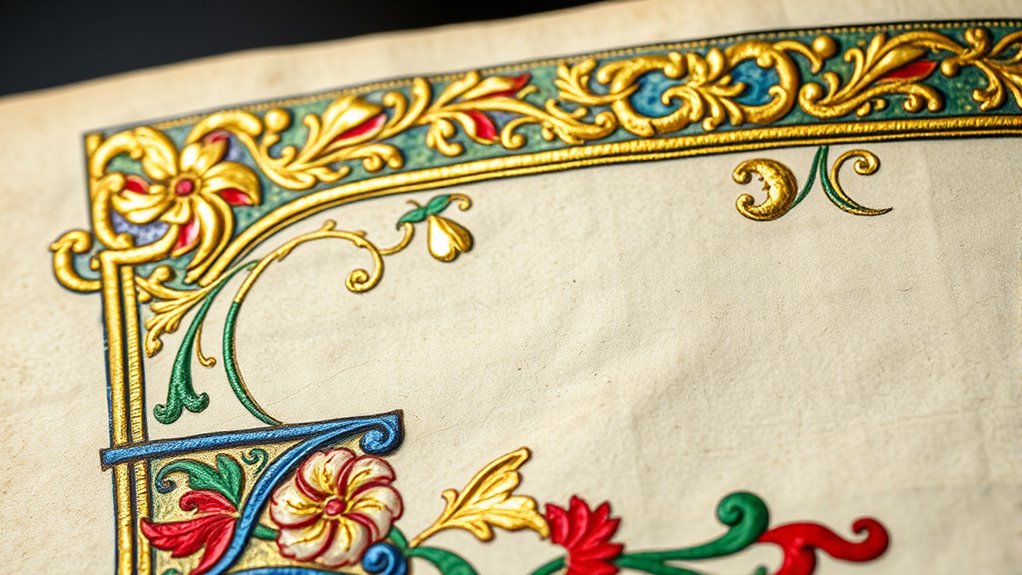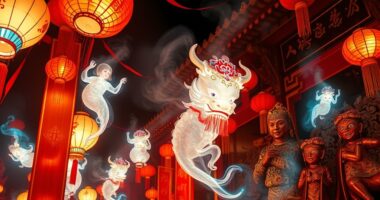Illuminated manuscripts use shimmering gold and vibrant pigments to create stunning visual effects that reflect divine light and spiritual truth. Artists carefully apply layers of mineral and plant-based colors, often accenting details with gold leaf to symbolize heaven’s glory and eternal truth. These intricate designs serve as sacred symbols, inspiring reverence and devotion. If you keep exploring, you’ll discover how every brushstroke and gold detail transforms plain parchment into a luminous masterpiece of faith and artistry.
Key Takeaways
- Gold leaf was used to symbolize divine light and heaven’s glory, creating luminous, radiant effects on illuminated pages.
- Vibrant pigments derived from minerals, plants, and stones were meticulously prepared for detailed and vivid imagery.
- Gold and pigments were applied in layered techniques, enhancing depth, luminosity, and spiritual symbolism in manuscripts.
- The interplay of gold and pigments transformed plain parchment into visually captivating artwork reflecting divine truths.
- Light and color in illuminated manuscripts aimed to inspire reverence, faith, and spiritual reflection in viewers.

Have you ever wondered how medieval artisans transformed plain parchment into stunning works of art? It’s a fascinating process rooted in medieval artistry, where skill and devotion combine to create illuminated manuscripts that still captivate us today. These manuscripts weren’t just texts; they were visual masterpieces that conveyed religious stories and symbolism with incredible detail and beauty. Every page was carefully crafted to serve both as a spiritual guide and a testament to the artisan’s craftsmanship. You might imagine the painstaking process involved—applying layers of vibrant pigments, delicate gold leaf, and intricate designs—all to enhance the sacred words they contained. The use of religious symbolism was central to their purpose, turning each page into a visual reflection of divine truths. These symbols—like the lamb representing Christ or the cross symbolizing salvation—weren’t just decorative; they carried deep spiritual meaning, guiding viewers into contemplation and faith. As you look at an illuminated manuscript, you can sense how medieval artists imbued their work with reverence and purpose, transforming simple materials into sacred objects. The skill required to create these pieces was extraordinary. Artists used fine brushes made from animal hair, and they prepared their pigments with great care, often mixing ground minerals, plants, and even precious stones. Gold leaf, applied with meticulous precision, added a radiant glow that seemed to light up the pages from within. This shimmering gold wasn’t just a decorative element; it symbolized divine light, eternal truth, and heaven’s glory. The combination of vivid pigments and reflective gold created a luminous effect that drew the viewer’s eye and elevated the manuscript beyond mere words. The process itself was highly labor-intensive, often taking months or even years to complete a single manuscript. Every detail was deliberate—the ornate initials, the decorative borders, and the miniature illustrations—all worked together to tell stories and reinforce religious messages. This meticulous craftsmanship was driven by faith, with artists dedicating their talents to produce objects that would inspire and educate believers. When you consider the effort involved, it’s clear that illuminated manuscripts were more than books; they were sacred artifacts designed to serve as windows into divine mysteries. Their beauty and symbolism continue to speak across centuries, reminding us of the profound connection between art, faith, and human devotion during the medieval period.
Frequently Asked Questions
How Were Illuminated Manuscripts Preserved Over Centuries?
You can preserve illuminated manuscripts over centuries through careful manuscript conservation and historical preservation techniques. Store them in stable environments with controlled temperature, humidity, and minimal light exposure to prevent deterioration. Handle them with gloves and support fragile areas during examination. Regular inspections and professional conservation efforts help repair and stabilize the materials, ensuring the manuscripts remain intact for future generations. Proper preservation methods keep these precious artifacts accessible and vibrant over time.
What Are the Most Rare and Valuable Illuminated Manuscripts?
You’ll find that the most rare and valuable illuminated manuscripts feature precious illuminations and are made on rare parchment. These masterpieces often include intricate gold leaf, vibrant pigments, and detailed imagery, making them highly sought after by collectors. Their rarity increases due to limited surviving copies, age, and historical significance. Owning such a manuscript means holding a priceless piece of history, art, and religious devotion in a single, beautifully crafted artifact.
How Did the Production of Illuminated Manuscripts Influence Medieval Society?
Your curiosity about how illuminated manuscripts impacted medieval society starts with their role in raising rural literacy. By showcasing stunning monastic craftsmanship, these manuscripts made learning more accessible and admired. They fostered faith, reinforced cultural values, and created connections between clergy and communities. As a result, illuminated manuscripts propelled progress, preserved knowledge, and promoted a shared sense of identity, shaping the social and spiritual landscape of medieval life.
What Technological Methods Are Used to Analyze Manuscript Materials Today?
Today, you can analyze manuscript materials using advanced techniques like spectroscopic analysis and digital imaging. Spectroscopic analysis helps identify pigments and gold leaf by examining how they absorb and emit light, revealing their chemical composition. Digital imaging allows you to uncover hidden details and original colors through high-resolution scans. These methods enable non-invasive study, preserving delicate manuscripts while providing deep insights into their materials and craftsmanship.
Are There Modern Artists Inspired by Illuminated Manuscript Techniques?
Did you know that over 65% of modern artists draw inspiration from illuminated manuscript techniques? You’ll find a vibrant calligraphy revival fueling contemporary manuscript-inspired art, blending traditional craftsmanship with modern styles. Many artists incorporate gold leaf, intricate lettering, and luminous pigments into their work, creating a bridge between historic illumination and today’s creative expressions. If you’re into visual storytelling, this fusion offers endless inspiration for your own art projects.
Conclusion
As you explore illuminated manuscripts, you realize how their shimmering gold and vibrant pigments mirror the brilliance of everyday moments. It’s almost a coincidence how these ancient artworks continue to light up our imagination, connecting past and present. Just like a unexpected flash of inspiration, their intricate details remind you that beauty often hides in the most unexpected places. So, next time you see a gleaming page, remember—you’re witnessing a centuries-old light that still sparks wonder.









